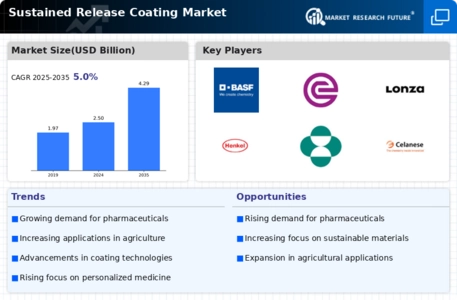Focus on Environmental Sustainability
The Sustained Release Coating Market is increasingly aligning with the global focus on environmental sustainability. As regulatory pressures mount and consumer preferences shift towards eco-friendly products, manufacturers are compelled to develop sustainable coating solutions. Biodegradable and non-toxic materials are gaining prominence, as they offer a viable alternative to traditional coatings that may pose environmental risks. This shift is not only beneficial for the planet but also opens new market opportunities, as companies that prioritize sustainability are likely to attract environmentally conscious consumers. Recent market analyses suggest that the demand for sustainable coatings could account for nearly 30% of the total market by 2030. This trend indicates a significant transformation within the industry, as stakeholders adapt to the growing emphasis on sustainability in product development and manufacturing processes.
Expansion in Agricultural Applications
The Sustained Release Coating Market is witnessing notable expansion in agricultural applications, driven by the need for efficient nutrient delivery systems. As the global population continues to rise, the demand for sustainable agricultural practices has intensified. Sustained release coatings are increasingly being utilized to encapsulate fertilizers and pesticides, allowing for controlled release over extended periods. This method not only enhances the effectiveness of these products but also reduces environmental impact by minimizing runoff and leaching. Recent studies indicate that the agricultural segment is projected to grow at a CAGR of around 5% in the coming years, reflecting the industry's shift towards more sustainable practices. The adoption of sustained release coatings in agriculture is likely to contribute significantly to the overall growth of the market, as stakeholders seek innovative solutions to meet the challenges of modern farming.
Rising Demand in the Pharmaceutical Sector
The Sustained Release Coating Market is significantly influenced by the rising demand for sustained release formulations in the pharmaceutical sector. As healthcare providers and patients seek more effective treatment options, the need for medications that provide prolonged therapeutic effects has become paramount. This trend is reflected in the increasing number of drug formulations utilizing sustained release coatings, which enhance patient compliance by reducing the frequency of dosing. According to recent data, the pharmaceutical segment accounts for over 40% of the total market share, indicating a robust growth trajectory. The sustained release coatings not only improve the bioavailability of drugs but also minimize side effects, making them a preferred choice among pharmaceutical manufacturers. This growing demand is expected to propel the market forward, as companies strive to innovate and expand their product offerings.
Increasing Investment in Research and Development
The Sustained Release Coating Market is experiencing a surge in investment in research and development, which is crucial for driving innovation and enhancing product offerings. Companies are recognizing the importance of developing advanced coating technologies that can meet the diverse needs of various sectors, including pharmaceuticals, agriculture, and food packaging. This investment is not only aimed at improving existing products but also at exploring new applications for sustained release coatings. Recent data indicates that R&D expenditures in this sector have increased by approximately 15% over the past two years, reflecting a strong commitment to innovation. As a result, the market is likely to witness the introduction of novel coating solutions that offer improved performance and sustainability, further propelling growth in the coming years.
Technological Innovations in Sustained Release Coating
The Sustained Release Coating Market is experiencing a surge in technological innovations that enhance the performance and efficiency of coating materials. Recent advancements in polymer chemistry and nanotechnology have led to the development of more effective sustained release coatings. These innovations allow for better control over drug release profiles, which is particularly beneficial in pharmaceutical applications. For instance, the introduction of biodegradable polymers has gained traction, as they offer environmentally friendly alternatives while maintaining efficacy. The market is projected to grow at a compound annual growth rate (CAGR) of approximately 6% over the next five years, driven by these technological advancements. As a result, manufacturers are increasingly investing in research and development to create novel coating solutions that meet the evolving needs of various industries.

















Leave a Comment